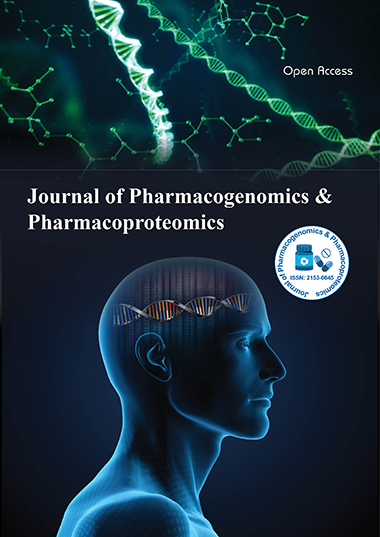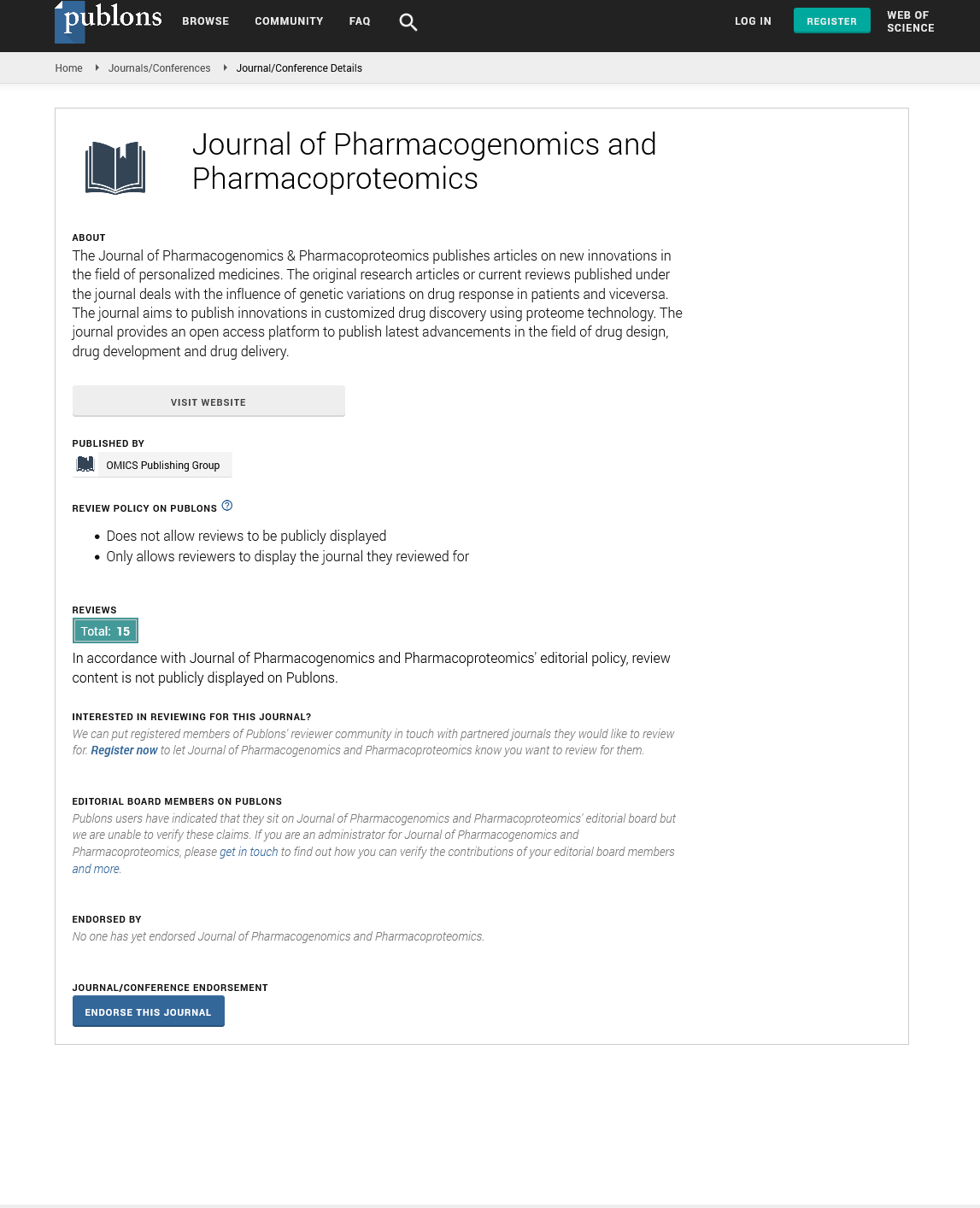Indexed In
- Open J Gate
- Genamics JournalSeek
- Academic Keys
- JournalTOCs
- ResearchBible
- Electronic Journals Library
- RefSeek
- Hamdard University
- EBSCO A-Z
- OCLC- WorldCat
- Proquest Summons
- SWB online catalog
- Virtual Library of Biology (vifabio)
- Publons
- MIAR
- Euro Pub
- Google Scholar
Useful Links
Share This Page
Journal Flyer

Open Access Journals
- Agri and Aquaculture
- Biochemistry
- Bioinformatics & Systems Biology
- Business & Management
- Chemistry
- Clinical Sciences
- Engineering
- Food & Nutrition
- General Science
- Genetics & Molecular Biology
- Immunology & Microbiology
- Medical Sciences
- Neuroscience & Psychology
- Nursing & Health Care
- Pharmaceutical Sciences
Opinion Article - (2022) Volume 13, Issue 3
Toxicoproteomics and Biomarker in the Study of Liver Disease
Elizabeth Sodurlund*Received: 02-May-2022, Manuscript No. JPP-22-16791; Editor assigned: 06-May-2022, Pre QC No. JPP-22-16791(PQ); Reviewed: 20-May-2022, QC No. JPP-22-16791; Revised: 27-May-2022, Manuscript No. JPP-22-16791(R); Published: 06-Jun-2022, DOI: 10.35248/2153-0645.22.13.015
Description
Toxicoproteomics is a type of toxicology testing and study that uses global protein measurement technology. The field's goals include figuring out how essential proteins in critical biological pathways cause bad drug effects, developing biomarkers, and eventually predicting toxicity using pharmacogenomics data. Proteomic applications to a growing variety of established scientific disciplines have sparked curiosity and excitement in basic biology, medicine, and toxicology [1]. Toxicoproteomics began as a subfield of toxic genomics and proteomics, but it has since grown into its own study.
Toxicoproteomics is defined by the goal of improving mechanistic understanding of how specific exposures alter protein expression, protein behavior, and response to cause injury and disease, but it has also been influenced by a growing body of research focusing on key organs like the liver and kidney. Tools from proteomics, bioinformatics, and other enabling high throughput technologies have been added to the field. Surprisingly, it may be argued that the overt pursuit of biomarker definition as a main goal in toxicoproteomics research is not appropriate or correct [2]. Biomarkers should be a logical continuation of research excellence from revealing toxic processes or modes of chemical action in response to acute hazardous exposure or during the long-term development of diseases caused or impacted by these exposures. The identification of biomarkers may be or should be a smaller component of the overall picture of toxicoproteomics when compared to such an important task. Biomarker and toxicity signature discovery, on the other hand, is a major motivator for those who employ proteomics in toxicology [3]. The commercial necessity to find indicators associated with drug exposure, efficacy, or toxicity in the pharmaceutical arena, as well as the urgencies of environmental hazard evaluation for public health protection, are major drivers in toxicoproteomics. Finally, a common thread running through all discovery strategies is that a mechanistic understanding of larger biochemical systems and signaling networks will lead to the eventual placement of protein alterations into biochemical pathways and processes. Transcriptomics, proteomics, interatomic, and metabolomics have all become part of systems biology.
Toxicoproteomics study in liver disease
The liver is the body's primary organ for biotransformation and pharmaceutics excretion. As a result, early toxicoproteomics investigations used rat models of toxicity to gain insight into drug-induced liver impairment. Many animal models of liver toxicity are chosen for the prevalence of a single phenotype, such as necrosis, hepatitis, cholestasis, steatosis, fibrosis, cirrhosis, or malignancy, yet many of these molecular processes happen at the same time. The recall of several widely prescribed drugs due to hepatotoxicity has drawn widespread attention, highlighting underlying susceptibility factors to drug induced injury such as age, sex, drug-drug interactions, and genetic polymorphism in metabolic pathways involved in therapeutic drug activation or disposition. Some substances may dysregulate important metabolic pathways or activities of the liver, or reactive intermediates created during metabolism may be harmful. In Toxicoproteomics studies of the liver, acetaminophen (N-Acetylp- Aminophenol, APAP) has been one of the most commonly examined drugs for producing hepatic damage. In most preclinical species, it causes centrilobular hepatic necrosis [4]. Acute hepatic injury caused by acetaminophen is predominantly caused by CYP2E1 bio activation, which produces reactive intermediates such N-Acetyl-P-Benzoquinone Imine (NAPQI), which depletes Glutathione and then attach to important cellular macromolecules. Mitochondria are assumed to be the principal targets of acetaminophen toxicity, with the mitochondrial permeability transition receiving special focus. It's worth mentioning that mitochondrial dysfunction is at the root of a number of toxicities in preclinical animals, particularly in the liver, skeletal and cardiac muscle, and the Central Nervous System (CNS).
Non-parenchymal cells that release cytokines and chemokine’s during acetaminophen-induced liver injury, such as Kupffer cells, NK cells, neutrophils, and endothelial cells, have also been implicated. Standard 2D-MS analysis as well as the 2D-DIGE-MS platform alone or in combination with DNA microarrays was used in some of the first toxicoproteomics research using 2D-MS platforms [5]. Changed proteins known to be targets for adduct formation, such as mitochondrial proteins, Heat Shock Proteins (HSPs), and other structural and intermediary metabolic proteins, were found in the livers of mice in these research. In rat liver and HepG2 cells, a novel type of 2D gel separation using a Non-Equilibrium pH Gel Electrophoresis (NEPHGE) approach to charge separation of proteins discovered 100 to 200 differently expressed proteins, particularly in intermediate metabolic enzymes.
Citation: Sodurlund E (2022) Toxicoproteomics and Biomarker in the Study of Liver Disease. J Pharmacogenom Pharmacoproteomics. 13:015.
Copyright: © 2022 Sodurlund E. This is an open-access article distributed under the terms of the Creative Commons Attribution License, which permits unrestricted use, distribution, and reproduction in any medium, provided the original author and source are credited.

